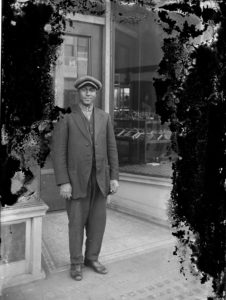
By Thomas Robinson
This tantalizing image was first shown twenty years ago in the exhibit A Portland Family Album; Self-Portrait of an African-American Community. Christopher Rauschenburg, Richard Brown and I, along with an army of helpers, produced the 115-print show, which, because of its size, was co-hosted by the Blue Sky Gallery and the Interstate Firehouse Cultural Center. This month, I’m digitizing the collection to put on the Blue Sky Gallery website.
The source of this image is a glass plate negative, taken by an Oregon Journal staff photographer in the fall or winter of 1915-16. The plate had been in a flood and lost about a third of its emulsion. Over the last twenty years I’ve often wished that the location could be identified. The best clue was the street number address above the doorway, which was “26”. Last week, I checked the 1915 Portland city directory’s classified business listings for cigar stores. There was only one cigar store with that address in the areas of downtown using glass blocks in the sidewalk cement that you see in this photo. These were called Vault Lights and were used to illuminate basements with natural daylight. Most nineteenth-century downtown buildings had hollow sidewalks with cellars beneath. Vault lights had, in many cases, prisms on the bottom side to direct the light around the basement, illuminating every corner with daylight.
For scanning glass plates, I’m now using a scanner mounting fluid to cover the emulsion (with a mylar overlay on top to prevent the fluid from evaporating, which otherwise it would do in a matter of seconds). The fluid greatly reduces refraction and bruises in the emulsion; the result looks almost like the picture was taken yesterday by a digital camera.
For the rest of the exhibit, sometimes I still have access to an original print and I’ll scan that, otherwise I’m drum-scanning the copy negatives I made to print the 1995 exhibit.